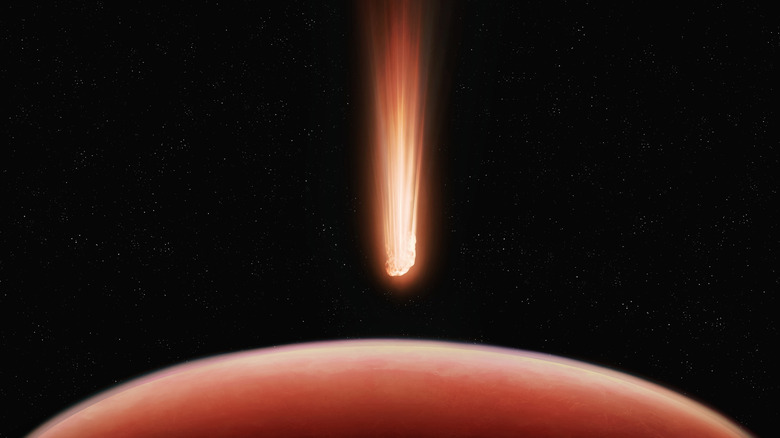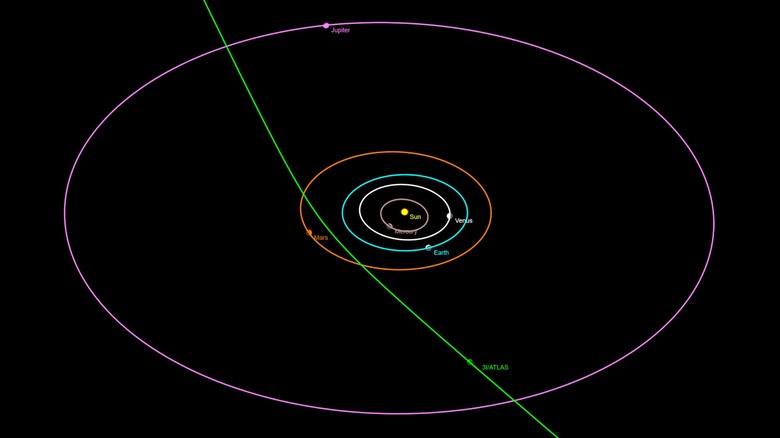NASA Just Spotted A Comet In Our Solar System And It's Not Like All The Rest
The universe is full of unknown celestial objects, and scientists have only begun to scratch the surface of understanding what's within and beyond our solar system. Among these many objects are comets that orbit the sun, regularly passing Earth. The "devil comet" that has been closest to Earth — Comet 12P/Pons-Brooks in June 2024 — is just one example. Generally, these comets originate from the Kuiper Belt or Oort Cloud at the far reaches of the solar system. The newest comet detected by researchers, though, isn't like the rest because it didn't originate in our solar system.
Officially named 3I/ATLAS, this new interstellar object was spotted with the Asteroid Terrestrial-impact Last Alert System (ATLAS) survey telescope on July 1, 2025, by astronomers in Rio Hurtado, Chile. After that initial report to the Minor Planet Center, "pre-discovery" observations by three other international ATLAS telescopes and the Zwicky Transient Facility at Caltech's Palomar Observatory were gathered to get more information about the comet. They determined that it arrived from the direction of the Sagittarius constellation (the central region of the Milky Way) and, at the time of discovery, was already within Jupiter's orbit but still about 410 million miles from the sun.
It's estimated that 3I/ATLAS is moving at about 137,000 mph and will travel through the inner solar system by October. According to the trajectory, the comet will remain about 150 million miles away from Earth (posing no danger to our planet) and about 130 million miles from the sun. However, it will get much closer to Mars, possibly close enough that the Mars Reconnaissance Orbiter will be able to see it.
Why the 3I/ATLAS comet is so special
Based on international observation archives from various instruments, astronomers think that the 3I/ATLAS comet could measure up to 12.4 miles wide. They've also been able to determine that the interloper is from interstellar space by analyzing its trajectory and speed. In fact, it's moving so fast that it's obviously not bound in an orbit by the gravity of the sun and is just passing through the solar system. They were also able to categorize it as a comet rather than asteroid because, according to the Minor Planet Center, a few scientists were able to see a short tail behind it, indicating the ventilation of dust and gas.
Aside from its truly otherworldly origin, 3I/ATLAS is so special because it's only the third object of its kind to be detected passing through our solar system. The two others that astronomers know of are 1I/'Oumuamua from 2017 and 2I/Borisov from 2019, and 3I/ATLAS is traveling faster than either of them and is predicted to be a much older remnant of a planetary system light-years from our own. University of Canterbury astronomer Michele Bannister in New Zealand expressed her excitement about studying these comets to Nature, "Working on 1I and 2I were transformational opportunities."
Just like NASA tracking a rare planet unlike anything in our solar system — an exoplanet named Enaiposha — researchers around the world are contributing to 3I/ATLAS tracking efforts. So far, they expect ground-based telescopes to have a view of the comet through September, after which it will be passing so close to the sun that they won't be able to see it. By early December, though, it's expected to return to view so that scientists can continue observing its behavior and composition before it's gone.

